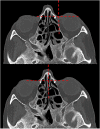Use of the medial canthal point (MCP) as a reliable anatomical landmark to the frontal sinus
- PMID: 33134524
- PMCID: PMC7585238
- DOI: 10.1002/lio2.440
Use of the medial canthal point (MCP) as a reliable anatomical landmark to the frontal sinus
Abstract
Objectives: Frontal sinus surgery is considered one of the more challenging aspects of Functional Endoscopic Sinus Surgery, due to the complex variations in normal sinus anatomy but also increased morbidity due to the close proximity of critical structures such as the anterior cranial fossa and orbits. We aim to investigate the medial canthal point (MCP) as an anatomical landmark for safe frontal sinus access.
Methods: The MCP intranasally is identified during surgery with non-tooth forceps, with one limb just anterior to the medial canthus and the other intranasally in the same coronal plane along the skull base. This point was identified on 100 paranasal sinus computed tomography (CT) scan reconstructions. The distance between the anterior cranial fossa and MCP was measured on imaging-medial canthal point distance (MCPD). The maximal anterior-posterior (AP) distance was measured on all scans.
Results: The average MCPD for males was 13.0 mm (8.7-20.4 mm) and for females 12.0 mm (6.8-22.8 mm). Mean AP distance for males was 12.0 mm (4.5-20.2 mm) and for females 10.4 mm (3.8-15.9 mm). Mean distance for all 100 patients was 12.6 mm (range 7.5-22.8 mm). In all cases, the MCP was anterior to the cranial fossa. Mixed effects modelling analysis showed a significant correlation between the MCPD and AP distance (P = .006).
Conclusion: The MCP is a consistent anatomical landmark that can serve as an adjunct to safe frontal sinus access alongside the first olfactory fiber and CT navigation systems. However, patient selection continues to be very important, with larger well pneumatized frontal sinuses being ideal to tackle earlier in a surgeon's career.
Level of evidence: NA.
Keywords: anterior skull base; frontal sinus; medial canthal point.
© 2020 The Authors. Laryngoscope Investigative Otolaryngology published by Wiley Periodicals LLC on behalf of The Triological Society.
Figures





Similar articles
-
First olfactory fiber as an anatomical landmark for frontal sinus surgery.Laryngoscope. 2016 May;126(5):1039-45. doi: 10.1002/lary.25696. Epub 2015 Oct 22. Laryngoscope. 2016. PMID: 26490546
-
Lateral frontal sinus access in endoscopic skull-base surgery.Int Forum Allergy Rhinol. 2011 Jul-Aug;1(4):290-5. doi: 10.1002/alr.20042. Epub 2011 Apr 14. Int Forum Allergy Rhinol. 2011. PMID: 22287434
-
Anatomical Measurement as a Reference for Functional Endoscopic Sinus Surgery Based on CT Scans and Dissections.Int Arch Otorhinolaryngol. 2024 Jul 5;28(3):e424-e431. doi: 10.1055/s-0043-1777447. eCollection 2024 Jul. Int Arch Otorhinolaryngol. 2024. PMID: 38974636 Free PMC article.
-
[Anatomy and imaging study of a new upper-agger nasi pathway of frontal sinus surgery].Lin Chuang Er Bi Yan Hou Tou Jing Wai Ke Za Zhi. 2014 Oct;28(20):1555-9. Lin Chuang Er Bi Yan Hou Tou Jing Wai Ke Za Zhi. 2014. PMID: 25764751 Chinese.
-
Anatomical variations of anterior ethmoidal artery and their significance in endoscopic sinus surgery: a systematic review.Surg Radiol Anat. 2019 May;41(5):491-499. doi: 10.1007/s00276-018-2165-3. Epub 2018 Dec 12. Surg Radiol Anat. 2019. PMID: 30542930
References
-
- Bolger WE, Stammberger H, Ishii M, Ponikau J, Solaiyappan M, Zinreich SJ. The anterior Ethmoidal “Genu”: a newly appreciated anatomic landmark for endoscopic sinus surgery. Clin Anat. 2019;32(4):534‐540. - PubMed
-
- Weber R, Draf W, Kratzsch B, Hosemann W, Schaefer SD. Modern concepts of frontal sinus surgery. Laryngoscope. 2001;111(1):137‐146. - PubMed
-
- Draf W. Endonasal frontal sinus drainage type I–III according to Draf The Frontal Sinus. Berlin, Heidelberg: Springer; 2005:219‐232.
-
- Upadhyay S, Buohliqah L, Vieira Junior G, Otto BA, Prevedello DM, Carrau RL. First olfactory fiber as an anatomical landmark for frontal sinus surgery. Laryngoscope. 2016;126(5):1039‐1045. - PubMed
-
- Scott NA, Wormald P, Close D, Gallagher R, Anthony A, Maddern GJ. Endoscopic modified Lothrop procedure for the treatment of chronic frontal sinusitis: a systematic review. Otolaryngol Head Neck Surg. 2003;129(4):427‐438. - PubMed
LinkOut - more resources
Full Text Sources
Research Materials
Miscellaneous
